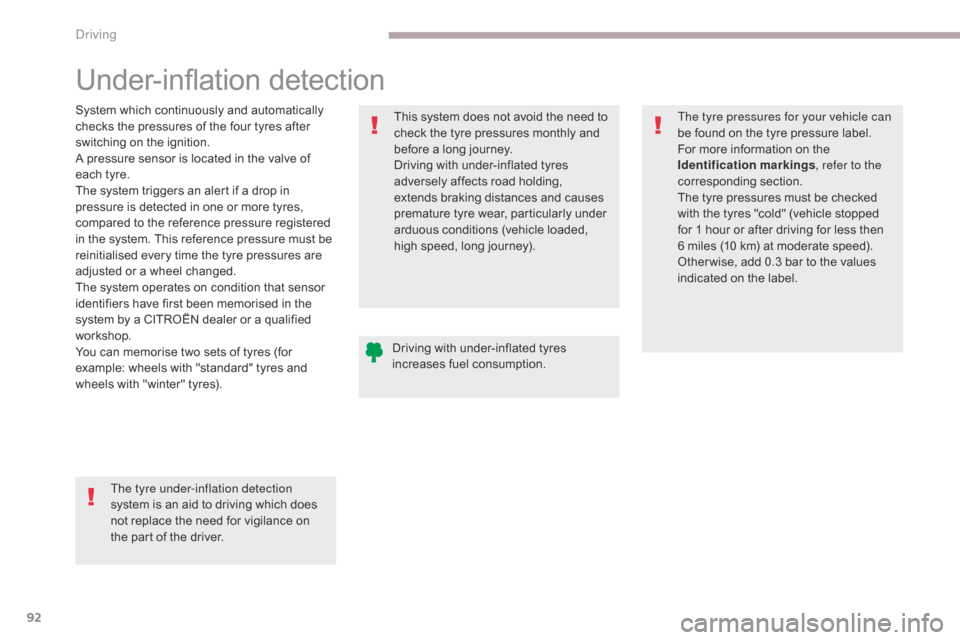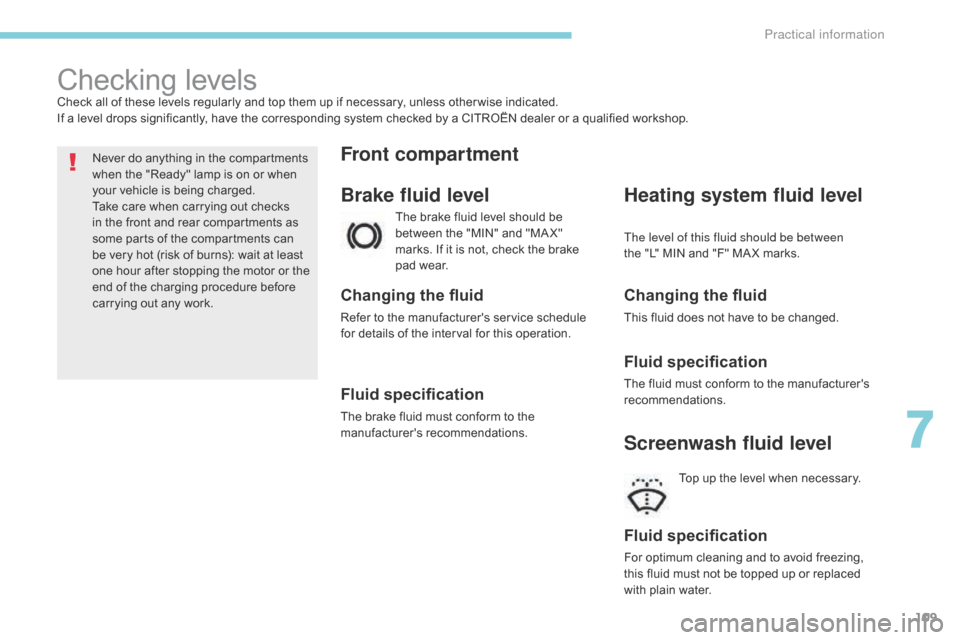ESP Citroen C ZERO 2017 1.G Owner's Guide
[x] Cancel search | Manufacturer: CITROEN, Model Year: 2017, Model line: C ZERO, Model: Citroen C ZERO 2017 1.GPages: 174, PDF Size: 4.57 MB
Page 94 of 174

92
C-Zero_en_Chap06_conduite_ed01-2016
Under-inflation detection
System which continuously and automatically
checks the pressures of the four tyres after
switching on the ignition.
A pressure sensor is located in the valve of
each tyre.
The system triggers an alert if a drop in
pressure is detected in one or more tyres,
compared to the reference pressure registered
in the system. This reference pressure must be
reinitialised every time the tyre pressures are
adjusted or a wheel changed.
The system operates on condition that sensor
identifiers have first been memorised in the
system by a CITROËN dealer or a qualified
workshop.
You can memorise two sets of tyres (for
example: wheels with "standard" tyres and
wheels with "winter" tyres).The tyre under-inflation detection
system is an aid to driving which does
not replace the need for vigilance on
the part of the driver. This system does not avoid the need to
check the tyre pressures monthly and
before a long journey.
Driving with under-inflated tyres
adversely affects road holding,
extends braking distances and causes
premature tyre wear, particularly under
arduous conditions (vehicle loaded,
high speed, long journey).
Driving with under-inflated tyres
increases fuel consumption. The tyre pressures for your vehicle can
be found on the tyre pressure label.
For more information on the
Identification markings
, refer to the
corresponding section.
The tyre pressures must be checked
with the tyres "cold" (vehicle stopped
for 1 hour or after driving for less then
6 miles (10 km) at moderate speed).
Other wise, add 0.3 bar to the values
indicated on the label.
Driving
Page 97 of 174

95
C-Zero_en_Chap06_conduite_ed01-2016
Managing sets of wheels
and tyres
Selection of the other set of wheels and tyres is
done via the instrument panel screen, with the
ignition on and the vehicle stationary.
After fitting the new set of wheels and
tyres, you should check and adjust the
tyre pressures to the values specified
on the tyre pressure label.
For more information on the
Identification markings , refer to the
corresponding section. The system automatically reinitialises
the reference pressure based on the
pressure in the new set (the under-
inflation detection warning lamp flashes
during the operation).
If you have had a second set of wheels and
tyres registered by a CITROËN dealer or a
qualified workshop, every time you change the
set of wheels (fitting a set of winter tyres, for
example), you must select the set you have just
fitted in the configuration menu.
F
P
ress button A to select the function.
F
P
ress and hold button A button for more
than 10 seconds to change successively
from set of wheels and tyres 1 to set of
wheels and tyres 2 or the other way round.
6
Driving
Page 98 of 174

96
TOTAL & CITROËN
TOTAL and CITROËN personnel combine their
talents to optimise the efficient use of energy and
reduce the impact on the environment.
The partnership between our two groups, which is on
an international scale, does not merely amount to the
supply and maintenance of vehicles to the public: our
positions as industrial leaders allow us to meet the
environmental challenges of today and of tomorrow.
To provide ecologically responsible mobility to
everyone is more than our driving force, it is our
passion.
Innovation is under way, the future of the
automobile depends on it; we will meet the
challenges t o g e t h e r.
prefers
PARTNERS IN THE FUTURE
OF THE AUTOMOBILE
Practical information
Page 104 of 174

102
Control unit statuses
Lit in the corresponding indicator
lamp colour.Flashing in the corresponding
indicator lamp colour.
Of f.
POWER FA U LTCHARGING
Normal operation
As soon as the charging cable is connected to a socket, all of the indicator lamps come on for
approximately 0.5 second.
Once the initialisation process is complete:
●
i
f the charging cable is not connected to the vehicle's socket.
●
i
f the charging cable is connected to the vehicle's socket, but the vehicle is not charging.
When the traction battery is being charged.
When charging is complete.
POWER FA U LTCHARGING
Operating faults and solutions
If a current leak is detected or the charging cable is faulty.
-
S
top the charging procedure immediately and contact a CITROËN dealer or a qualified workshop.
If the charging cable is faulty.
-
S
top the charging procedure immediately and contact a CITROËN dealer or a qualified workshop.
If the indicator lamp on the control unit does not come on when the charging cable is connected to the
socket, check the socket's circuit breaker:
●
i
f the circuit breaker has cut out, your electrical installation may not be compatible with the use of the
charging cable:
-
c
ontact a professional to have your electrical installation checked and repaired.
●
i
f the circuit breaker has not cut out:
-
d
o not use the charging cable and contact a CITROËN dealer or a qualified workshop.
Practical information
Page 105 of 174

103
Using a public charging point for normal charging
Some public charging points include a charging cable.
In this case, use the cable provided.
In Mode 3, regardless of the power of the charging point, charging will be limited to 16 A maximum. For more information on the charging times,
refer to the Motor and main battery section.
Several types of electrical socket may be available for charging your vehicle.
Before starting the charging procedure, use the table below to identify the correct type of socket and use the corresponding charging cable.
Domestic power point "Mode 3 - Type 2" socket "Mode 3 - Type 3" socket
"Mode 2" cable
(supplied with your vehicle) "Mode 3 - Type 2" cable
(available as an accessory) "Mode 3 - Type 3" cable
(available as an accessory)
7
Practical information
Page 110 of 174

108
Rear compartmentLocated under the boot floor, this compartment gives access to the cooling system reservoir.
F
O
pen the boot.
F
D
etach the carpet retaining adhesive strip.
F
R
emove the boot carpet. F
R
emove the four "butter fly" screws.
F
R
emove the protective cover.F
C
heck the coolant level and top up if
necessary.
For more information on Checking
levels , refer to the corresponding
section.
When working in this compartment,
you must observe the safety
recommendations on the labels.
Practical information
Page 111 of 174

109
Checking levelsCheck all of these levels regularly and top them up if necessary, unless other wise indicated.
If a level drops significantly, have the corresponding system checked by a CITROËN dealer or a qualified workshop.Never do anything in the compartments
when the "Ready" lamp is on or when
your vehicle is being charged.
Take care when carrying out checks
in the front and rear compartments as
some parts of the compartments can
be very hot (risk of burns): wait at least
one hour after stopping the motor or the
end of the charging procedure before
carrying out any work.
Brake fluid level
The brake fluid level should be
between the "MIN" and "MA X"
marks. If it is not, check the brake
pad wear.
Changing the fluid
Refer to the manufacturer's service schedule
for details of the interval for this operation.
Fluid specification
The brake fluid must conform to the
manufacturer's recommendations.
Front compartment Heating system fluid level
Changing the fluid
This fluid does not have to be changed.
Fluid specification
The fluid must conform to the manufacturer's
recommendations. The level of this fluid should be between
the "L" MIN and "F" MA X marks.
Screenwash fluid level
Top up the level when necessary.
Fluid specification
For optimum cleaning and to avoid freezing,
this fluid must not be topped up or replaced
with plain water.
7
Practical information
Page 112 of 174

110
The coolant level should be between
the MIN "L" and MA X "F" marks.
Coolant levelAvoid prolonged contact of used fluids
with the skin.
Most of these fluids are harmful to
health and some are very corrosive.
Do not discard used fluids into sewers
or onto the ground.
Take used fluids to a CITROËN dealer
or a qualified workshop (France) or to
an authorised waste disposal site.
Used products
Rear compartment
Changing the coolant
The coolant does not have to be changed.
Coolant specification
The coolant must conform to the
manufacturer's recommendations. As the cooling system is pressurised, wait at
least one hour after switching off the motor
and/or the end of the charging cycle before
carrying out any work.
To avoid any risk of scalding, unscrew the cap
by two turns to allow the pressure to drop.
When the pressure has dropped, remove the
cap and top up the level.
12 V battery electrolyte
level
Remove the battery protective cover to check
this level.
For more information on the 12 V battery, refer
to the corresponding section.
The level of this fluid should be between the
MIN "LOWER LEVEL" and MA X "UPPER
LEVEL" marks.
If necessary, top up using distilled water by
removing the caps of the different battery
compartments.
Check the electrolyte level at least once
per month.
Practical information
Page 114 of 174

112
Changing a wiper
blade
Removing a front or rear
wiper blade
F Raise the corresponding wiper arm.
F R emove the wiper blade, sliding it towards
the outside.
Fitting a front or rear wiper
blade
F Put the new wiper blade in place and secure it.
F
F
old down the wiper arm carefully.
Precautions for
washing
To avoid damaging the electrical
components, the use of a high pressure
jet wash is strictly prohibited:
-
i
n the front compartment (under the
bonnet).
-
u
nder the body.
For washing the bodywork, do not use a
pressure greater than 80 bars. Check - before washing the vehicle -
that the charging flaps and the charging
socket covers (normal and fast charge)
are properly closed. Do not wash the vehicle while the
battery is being recharged.
Practical information
Page 116 of 174

114
C-Zero_en_Chap08_en-cas-de-panne_ed01-2016
F Lift the protective cover on the (+) terminal.F
C
onnect one end of the red cable to
the (+) terminal of your discharged
battery A , then the other end to
the (+) terminal of the battery on the
other vehicle B .
Starting using a battery on
another vehicle
F Connect one end of the green or black
cable to the (-) terminal of the battery on
the other vehicle B .
F
C
onnect the other end the green or black
cable to the earth point C of your vehicle.
Ensure that the electrolyte is not frozen.
Check the electrolyte level and top up
with distilled water if necessary.
For more information on Checking
levels
, refer to the corresponding
section. Check that the battery on the other
vehicle is a 12 V battery.
In the event of a breakdown